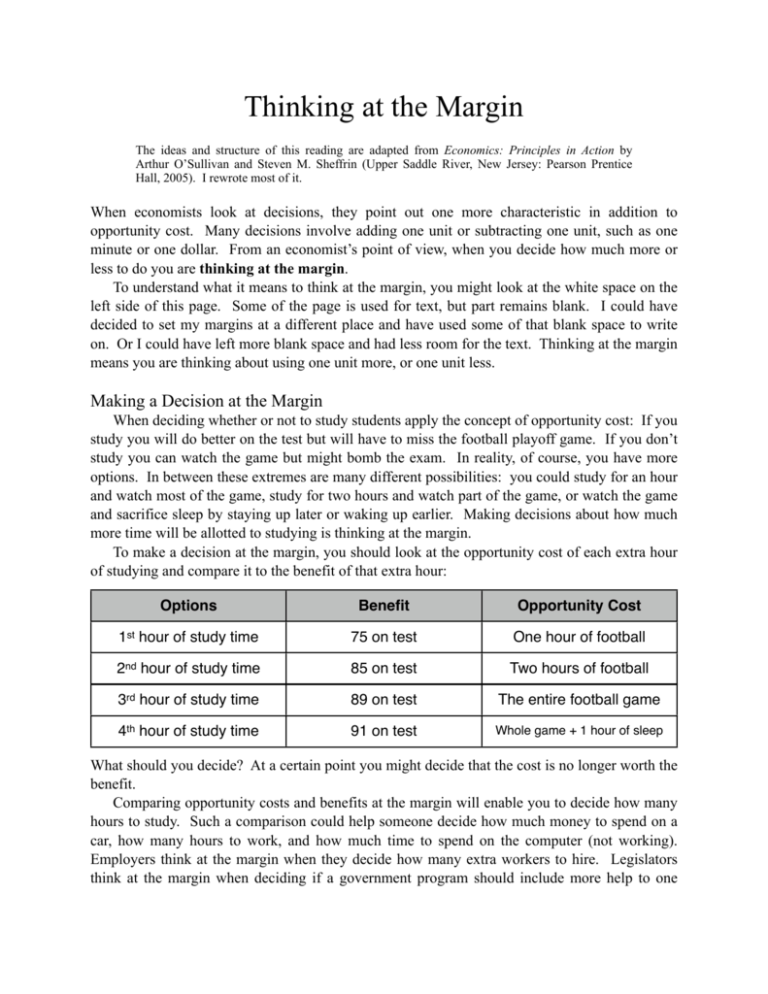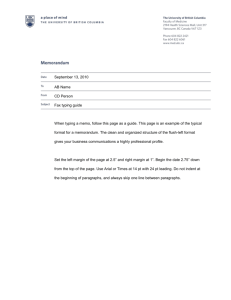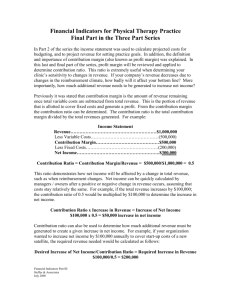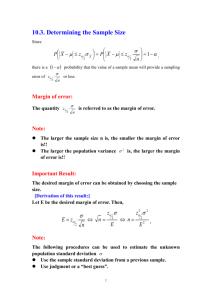
Thinking at the Margin
The ideas and structure of this reading are adapted from Economics: Principles in Action by
Arthur O’Sullivan and Steven M. Sheffrin (Upper Saddle River, New Jersey: Pearson Prentice
Hall, 2005). I rewrote most of it.
When economists look at decisions, they point out one more characteristic in addition to
opportunity cost. Many decisions involve adding one unit or subtracting one unit, such as one
minute or one dollar. From an economist’s point of view, when you decide how much more or
less to do you are thinking at the margin.
To understand what it means to think at the margin, you might look at the white space on the
left side of this page. Some of the page is used for text, but part remains blank. I could have
decided to set my margins at a different place and have used some of that blank space to write
on. Or I could have left more blank space and had less room for the text. Thinking at the margin
means you are thinking about using one unit more, or one unit less.
Making a Decision at the Margin
When deciding whether or not to study students apply the concept of opportunity cost: If you
study you will do better on the test but will have to miss the football playoff game. If you don’t
study you can watch the game but might bomb the exam. In reality, of course, you have more
options. In between these extremes are many different possibilities: you could study for an hour
and watch most of the game, study for two hours and watch part of the game, or watch the game
and sacrifice sleep by staying up later or waking up earlier. Making decisions about how much
more time will be allotted to studying is thinking at the margin.
To make a decision at the margin, you should look at the opportunity cost of each extra hour
of studying and compare it to the benefit of that extra hour:
Options
Benefit
Opportunity Cost
1st hour of study time
75 on test
One hour of football
2nd hour of study time
85 on test
Two hours of football
3rd hour of study time
89 on test
The entire football game
4th hour of study time
91 on test
Whole game + 1 hour of sleep
What should you decide? At a certain point you might decide that the cost is no longer worth the
benefit.
Comparing opportunity costs and benefits at the margin will enable you to decide how many
hours to study. Such a comparison could help someone decide how much money to spend on a
car, how many hours to work, and how much time to spend on the computer (not working).
Employers think at the margin when they decide how many extra workers to hire. Legislators
think at the margin when deciding if a government program should include more help to one
group while possibly raising the taxes of another. This decision-making process is sometimes
called cost/benefit analysis or marginal analysis.
Deciding by thinking at the margin is just like making any other decision. One must
compare the opportunity costs and the benefits—what you will sacrifice and what you will gain.
Once the opportunity cost outweighs the benefits, no more units should be added.
Problems
Directions: Below are five problems. You will need to think at the margins to find the
solutions. There’s some simple math here; you might find a calculator useful (and I promise
we’ll have no math problems harder than these this year).
1. You own a 100-spot parking garage in downtown Chicago. You have charged $1.00 per hour
for parking for a long time, and your lot is always full during the business day (9:00 AM to 5:00
PM). If you raise your price to $1.50 hour, only 65 people will use your garage. If the price is
$2.00 per hour only 54 people will park. At $2.50 per hour only 45 people will use your garage.
Where should you set your price? Why?
2. You have already spent $10,000 on a new coffee shop. When you started you anticipated
annual sales of $20,000. Thanks to the economic downturn you now anticipate your annual sales
will only be $8,000—and to make things worse, thanks to some construction delays you now
need to pony up another $3,000 to finish the shop. Should you finish construction, or walk away
now? Why?
3. The Metropolitan Opera has decided to perform Alban Berg’s opera Wozzeck. Many [foolish]
opera fans dislike this [awesome] opera because it contains music without traditional melodies and
harmonies. As a result, the MET has only sold half of the tickets at their face value of $225 each.
New York University wants to encourage its students to enjoy serious music, so it offers to pay
the MET $20 per seat for all available tickets still unsold 24 hours before each performance.
How should the MET decide? Should the MET make the deal? Why or why not?
4. An airline is trying to decide how much to charge passengers who fly standby. It costs the
airline $100,000 to fly the 200-seat plane from New York to Los Angeles. The plane is about to
take off with 24 empty seats. A standby passenger is waiting by the gate, but he only has $200.
Should the airline sell him a seat for that amount? Why or why not?
5. You own a store with 10 employees who collectively earn $350,000 per year in wages, for an
average of $35,000 per employee. Your store takes in $500,000 per year in revenue, so each
worker is earning an average of $15,000 in profit for you. Adding an additional employee will
raise total wage costs to $385,000 per year, while revenues rise to $537,000; each worker is now
making you an average profit of $13,818 per year Should you hire the eleventh worker? Why or
why not?










